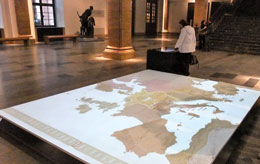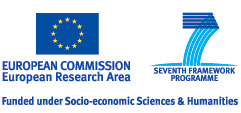The opening of Eunamus
Eunamus opening workshop:
Mapping and framing institutions 1750-2010
 29-30 April 2010
29-30 April 2010
Nationalmuseum Stockholm
National museums, their impressive buildings, their collections, and displays of scientific, historic and aesthetic objects, are remarkably familiar. Yet, what exactly constitutes a national museum is contested by historical actors as well as contemporary communities.
Eunamus' first workshop explored the various paradigms that shaped national museums and the connections that resulted in the spread of their particular forms. Link to programme
The workshop and its national reports from all over Europe laid out the contours of a museum geography of great complexity with several inbuilt paradoxes.
Even though national museums often claim national uniqueness and splendour, they are a genuinely transnational phenomenon. Most nations in Europe display very similar sets of collections of art, antiquities and archeological items, scientific collectables, armory, coins and ethnographica housed in impressive buildings open to the public.
But as pointed out by Ilaria Porciani already in her opening talk: “There seem to be yet another paradox in the very concept of national museums. In many countries there are a large numbers of museums, with national resonances, distributed all over the country. There is no single national museum, or a collection of big museums, in the capital”.
One of the important achievements of the workshop was the fine-tuning of an analytical and functional definition of a national museum to use in further research. Another was to focus less on individual museums and more on explaining the actors behind them and the resulting structure of an evolving institutional frame-work of national museums in each state.
The overview of the history of European national museums will aim to achieve several objectives: what museums and with which agendas have been established, when and by whom? The outset is comparative, looking at differences and similarities between the histories and landscapes of European national museums. With regard to the ways in which national museums connect to state making trajectories, the reports gave some really thought provoking examples, among them Latvia:
Since the interest in popular antiquities, wonders of nature and artefacts of fine arts gained form as collections available to general public, national museums in the territory of (contemporary) Latvia have undergone several stages of development. To begin with, they represented the interests of the Baltic German upper class; then, being owned by one of the richest municipalities, they became the pride of the Russian empire; in their next stage, they transformed into cultural treasuries of the emerging nation-state, and after that followed the period to serve as local archives representing the pre-Soviet past under the conditions of the communist regime. Today, Latvian national museums have acquired their status of national representatives in the contesting arena of independent European countries.
Toms Ķencis & Kristin Kuutma
The completed country reports will be further discussed at the conference Comparing National Museums 1750-2010 in Bologna March 30 – April, 2011. Link to conference proceedings
The public opening of Eunamus
Nationalmuseum
Stockholm
28 April 14-16 2010
The formal opening of Eunamus was open to the public and organized in collaboration with Nationalmuseum. Key-note speaker: Stephan Berger, Manchester University. Poster
Eunamus' opening was kindly hosted by Nationalmuseum and the director of the museum’s section for Research, Archives and Art Library, Associate professor Karin Sidén, proudly welcomed Eunamus to her institution’s lecture hall. Her introduction was followed by a presentation of the layout of the project by its coordinator Peter Aronsson.
Project partners raised a series of important questions that will guide future research within the project:
Who are the actors claiming ownership of the past? How can we answer that question by analyzing narratives of acquisition and claims for restitution? (Dominique Poulot)
How are the histories of Europe, its changing boundaries and its shared concepts, reflected in archeological and art historical collections? (Simon Knell)
Have national museums really changed due to the last decades of policy development regarding democratization and multiculturalism?
(Arne Bugge Amundsen)Do the national museums of today reflect the modern, diverse nations or do they remain irrelevant for large parts of the society? (Alexandra Bounia)
In what way does the fall of communism affect national museums in Central and South Eastern Europe? (Constantin Iordachi)
In his talk, Constantin Iordachi stressed that Eunamus is a truly European wide project. Eunamus not only focuses on Western Europe, but also on Northern Europe, Southern Europe, Central Europe, and Southeast Europe. Concordantly, Estonian partner Kristin Kuutma, hoped that she and her affiliated researchers would not only contribute with a reflective disciplinary history on heritage scholarship, but also bring onboard different experiences than researchers who explore the traditional centre of Europe.


